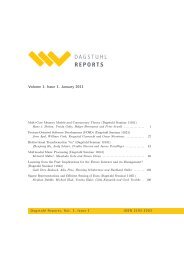Uncertainty modeling and analysis with intervals - DROPS - Schloss ...
Uncertainty modeling and analysis with intervals - DROPS - Schloss ...
Uncertainty modeling and analysis with intervals - DROPS - Schloss ...
You also want an ePaper? Increase the reach of your titles
YUMPU automatically turns print PDFs into web optimized ePapers that Google loves.
42 11371 – <strong>Uncertainty</strong> <strong>modeling</strong> <strong>and</strong> <strong>analysis</strong> <strong>with</strong> <strong>intervals</strong>: . . .<br />
Another good example is the case of heavy-tailed distributions frequently occurring in<br />
economics <strong>and</strong> finance: for these distributions, variance is infinite <strong>and</strong> thus, we cannot use<br />
variance to describe deviations from the mean.<br />
In such situations, a natural idea is to come up <strong>with</strong> characteristics tailored to specific<br />
application areas: e.g., select the characteristic that maximize the expected utility of the<br />
resulting risk-informed decision making. As a case study, we found optimal characteristics<br />
for measures of deviation <strong>and</strong> dependence in financial applications – where, for heavy-tailed<br />
distributions, traditional variance <strong>and</strong> correlation cannot be used.<br />
With the new characteristics, comes the need to estimate them when the sample values<br />
are only known <strong>with</strong> interval uncertainty. Algorithms originally developed for estimating<br />
traditional characteristics can often be modified to cover new characteristics.<br />
3.13 From Processing Interval-Valued Data to Processing Fuzzy Data:<br />
A Tutorial<br />
Vladik Kreinovich (University of Texas – El Paso, US)<br />
License Creative Commons BY-NC-ND 3.0 Unported license<br />
© Vladik Kreinovich<br />
Some quantities y are difficult (or impossible) to measure or estimate directly. A natural<br />
solution is to measure them indirectly, i.e., to measure auxiliary quantities x1, . . . , xn which<br />
are related to y by a known dependence y = f(x1, . . . , xn), <strong>and</strong> then use the results �xi of<br />
these measurements to compute an estimate �y = f(�x1, . . . , �xn) for y. Measurements are never<br />
absolutely accurate; as a result, the measurement results �xi are, in general, different from<br />
the actual (unknown) values xi of the corresponding quantities. Hence, the estimate �y is, in<br />
general, different from the desired value y. How can we estimate the difference ∆y = �y − y?<br />
In some cases, we know the probabilities of different measurement errors ∆xi = �xi − xi;<br />
however, often, we do not know these probabilities, we only know the upper bounds ∆i on<br />
the measurement errors – upper bounds provided by the manufacturers. In this case, after<br />
we know the measurement result �xi, we know that the actual value xi belongs to the interval<br />
[�xi − ∆i, �xi + ∆i], <strong>and</strong> we can use interval computations to find the interval of possible values<br />
of y.<br />
Often, in addition to the guaranteed bounds ∆i on the measurement errors, we also have<br />
expert estimates on these bounds which hold only <strong>with</strong> some degree of certainty – <strong>and</strong> which<br />
are described by words from natural language like “small”, “most probably”, etc,. Fuzzy<br />
techniques were specifially designed to process such estimates. The main idea is that, for<br />
each “fuzzy” (natural-language) property like “small”, <strong>and</strong> for each real value x, we describe<br />
the degree d(x) to which x satisfies this property – e.g., by polling experts. Once we know<br />
the degrees di(xi) to which each xi satisfies the corresponding expert property, we need to<br />
combine these degrees into a degree <strong>with</strong> which all the values xi satisfy their properties. We<br />
show how this need leads to a complex formula called Zadeh’s extension principle, <strong>and</strong> how<br />
from the computational viewpoint, it means that for each real value α ∈ [0, 1], to find all<br />
the values for which d(y) ≥ α (“α-cut” of y), we can apply interval computations to the<br />
corresponding α-cuts of xi. Thus, from the computational viewpoint, processing such fuzzy<br />
inputs can be (<strong>and</strong> usually is) reduced to interval computations.













